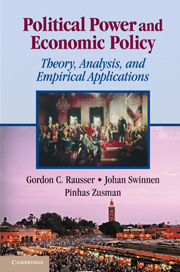Book contents
- Frontmatter
- Contents
- List of Figures
- List of Tables
- Preface
- PART 1 POLITICAL POWER AND ECONOMIC ANALYSIS
- 1 Public Policy: The Lens of Political Economy
- 2 The Nash Solution to the Bargaining Problem
- 3 The Harsanyi Solution to the Bargaining Problem
- 4 Political-Economic Analysis
- 5 Normative Political-Economic Analysis
- 6 Dynamic Political-Economic Analysis
- PART 2 IDEOLOGY, PRESCRIPTION, AND POLITICAL POWER COEFFICIENTS
- PART 3 ANALYSIS OF SPECIFIC STRUCTURES
- PART 4 EMPIRICAL APPLICATIONS OF POLITICAL POWER ESTIMATION
- References
- Index
1 - Public Policy: The Lens of Political Economy
Published online by Cambridge University Press: 05 June 2012
- Frontmatter
- Contents
- List of Figures
- List of Tables
- Preface
- PART 1 POLITICAL POWER AND ECONOMIC ANALYSIS
- 1 Public Policy: The Lens of Political Economy
- 2 The Nash Solution to the Bargaining Problem
- 3 The Harsanyi Solution to the Bargaining Problem
- 4 Political-Economic Analysis
- 5 Normative Political-Economic Analysis
- 6 Dynamic Political-Economic Analysis
- PART 2 IDEOLOGY, PRESCRIPTION, AND POLITICAL POWER COEFFICIENTS
- PART 3 ANALYSIS OF SPECIFIC STRUCTURES
- PART 4 EMPIRICAL APPLICATIONS OF POLITICAL POWER ESTIMATION
- References
- Index
Summary
Introduction
Conflicts between the public interest and special interests naturally emerge in the design and implementation of public policies. Some public policies pursue the public interest by attempting to correct for market imperfections, lower transaction costs, effectively regulate externalities, or enhance productivity. Still other public policies are the result of manipulation by powerful groups actively engaged in the pursuit of their own self-interest. Regardless, conceptual formulations that attempt to explain or prescribe public policy emphasizing only one type of interest are doomed to fail. Frameworks that neglect the role of special-interest groups have little explanatory power. Models that presume that government has neither autonomy nor any interest in the size of the economic pie will also face serious limitations as an explanatory, predictive, or prescriptive framework.
In any public-policy-making process, political and economic forces are at play in resolving the strategic interactions among the various interests. A schematic representation of the policy-making process reflecting these forces is represented in Figure 1.1. Historically, the right-hand box has been the domain of political science and the left-hand box has been the domain of economics. At the top of the right-hand box, particular governance structures set the constitutional design establishing voting rules, the rule of law, property rights, laws governing exchange, and more generally the rules by which rules are made. Governance structures also determine the nature and scope of the political feedback mechanisms of groups affected by public policies.
- Type
- Chapter
- Information
- Political Power and Economic PolicyTheory, Analysis, and Empirical Applications, pp. 3 - 29Publisher: Cambridge University PressPrint publication year: 2011



